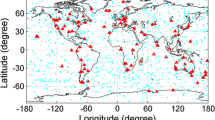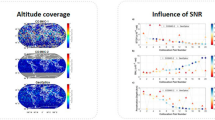Abstract
The existent satellite system for radio occultation monitoring the Earth’s neutral atmosphere and ionosphere (COSMIC) provides data to consumers in the regions with limited possibilities of constructing dense measurement networks (e.g., in the World Ocean area). A forthcoming increase of LEO small spacecrafts and the deployment of new satellite radio navigation systems will result in a pronounced increase in the efficiency of radio occultation method and its space resolution. As a result, the Space-Based Augmentation Systems (SBAS) broadband differential system will become global, or the quality of corrections delivered to single-frequency consumers of individual systems, e.g., the Augmentation and Monitoring System, will be improved. Therefore, the methods for processing and analyzing obtained radio occultation data should be improved. A simple method to reconstruct the electron density profile at radio occultation points, based on the total electron content measurement on the satellite–satellite path and the IRI-type ionospheric model has been proposed. The method needs initial information, it does not require refraction measurements, and it is free of the assumption that the ionosphere is spherically stratified in the occultation region. Verification of the proposed method based on data for 121 radio occultation cases across Europe in May 2013 demonstrated good agreement with the vertical sounding data.
Similar content being viewed by others
References
Andreeva, E.S. and Lokota, M.V., Ionospheric parameters: data from FORMOSAT-3/COSMIC, ionosondes, and IRI and NeQuick models, Sovrem. Probl. Distantsionnogo Zondirovaniya Zemli Kosmosa, 2014, vol. 11, no. 1, pp. 75–84.
Bakurskii, K.V., Zarubin, A.S., Myslivtsev, T.O., Savochkin, P.V., Sakhno, I.V., Troitskii, B.V., and Shpakov, A.P., Correction method of the ionosphere model using data from wide area navigation satellite systems, Geomagn. Aeron. (Engl. Transl.), 2014, vol. 54, no. 4, pp. 463–467.
Current and Planned Global and Regional Navigation Satellite Systems and Satellite-Based Augmentation Systems, International Committee on Global Navigation Satellite Systems, New York: United Nations, 2010.
Gulyaeva, T.L., Huang, X., and Reinich, B.W., The ionosphere–plasmasphere model software for ISO. Acta Geod. Geophys. Hung., 2002, vol. 39, no. 3, pp. 143–152.
Hajj, G.A. and Romans, L.J., Ionospheric electron density profiles obtained with the global positioning system: Results from GPS/MET experiment, Radio Sci., 1998, vol. 33, no. 1, pp. 175–190.
Hajj, G.A., Lee, L.C., Pi, X., Romans, L.J., Schreiner, W.S., Straus, P.R., and Wang, C., Cosmic GPS ionospheric sensing and space weather, Terr. Atmos. Ocean. Sci., 2000, vol. 11, no. 1, pp. 235–272.
Krankowski, A., Zakharenkova, I., and Krypiak-Gregorczyk, A., Ionospheric electron density observed by FORMOSAT-3/COSMIC over the European region and validated by ionosonde data, J. Geod., 2011, vol. 85, no. 12, pp. 949–964.
Panteleev, A.V. and Legova, T.A., Metody optimizatsii v primerakh i zadachakh (Optimization Methods: Examples and Problems), Moscow: Vysshaya shkola, 2002.
Stankov, S.M. and Jakowski, N., Topside ionospheric scale height analysis and modelling based on radio occultation measurements, J. Atmos. Sol.–Terr. Phys., 2006, vol. 68, no. 2, pp. 134–162.
Troitsky, B.V., Ortikov, M.Yu., Lobanov, K.A., et al., Ionospheric support of HF radiocommunication using maps of total electron content, Geomagn. Aeron. (Engl. Transl.), 2007, vol. 47, no. 3, pp. 389–394.
Author information
Authors and Affiliations
Corresponding authors
Additional information
Original Russian Text © T.O. Myslivtsev, S.V. Nikiforov, A.I. Pogoreltsev, P.V. Savochkin, I.V. Sakhno, A.A. Semenov, B.V. Troitsky, 2016, published in Geomagnetizm i Aeronomiya, 2016, Vol. 56, No. 4, pp. 489–495.
Rights and permissions
About this article
Cite this article
Myslivtsev, T.O., Nikiforov, S.V., Pogoreltsev, A.I. et al. Improving capabilities of broadband differential satellite navigation systems via radio occultation technology. Geomagn. Aeron. 56, 457–463 (2016). https://doi.org/10.1134/S0016793216040137
Received:
Accepted:
Published:
Issue Date:
DOI: https://doi.org/10.1134/S0016793216040137




